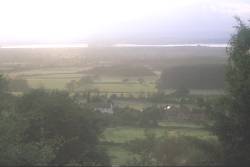 Approximately 11 % of Great Britain is covered by woodland or forest, and it is current Government policy is to expand the total area of woodland in the UK. In addition, it has committed itself to reducing the use of non-renewable energy sources and is promoting the establishment of biofuels such as Short Rotation Coppice (SRC). Combined with livestock diseases and other farming problems in Britain, there is an increasing interest in converting areas of farmland to non-agricultural uses. There is also an interest in establishing areas of new wet woodland. It is inevitable that proposals for new tree cover will involve some land with archaeological potential.
Approximately 11 % of Great Britain is covered by woodland or forest, and it is current Government policy is to expand the total area of woodland in the UK. In addition, it has committed itself to reducing the use of non-renewable energy sources and is promoting the establishment of biofuels such as Short Rotation Coppice (SRC). Combined with livestock diseases and other farming problems in Britain, there is an increasing interest in converting areas of farmland to non-agricultural uses. There is also an interest in establishing areas of new wet woodland. It is inevitable that proposals for new tree cover will involve some land with archaeological potential.
Where a Woodland Grant Scheme (WGS) application is received by the Forestry Commission to support new woodland establishment, the proposals must satisfy a wide range of requirements. These include protecting sites of archaeological importance. This process involves consultation with a nominated local authority archaeologist for the region in which the application is based. Advise is taken on what is known about the site and the application considered accordingly. Archaeological sites and associated areas of importance that can be identified from the records or fieldwork are excluded from the proposed scheme, or incorporated into planned open spaces.
 New woodland establishment is more problematic in areas with no known archaeology, but where the landscape is considered to be of high archaeological potential. In such circumstances, it is necessary to carry out a risk assessment to determine the probable nature of any archaeological evidence, the implications of woodland establishment and the options in devising a suitable mitigation strategy.
New woodland establishment is more problematic in areas with no known archaeology, but where the landscape is considered to be of high archaeological potential. In such circumstances, it is necessary to carry out a risk assessment to determine the probable nature of any archaeological evidence, the implications of woodland establishment and the options in devising a suitable mitigation strategy.
An example (PDF-1180K) in the historic environment section of the 2002-2003 Forest Research Annual Report.